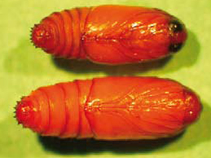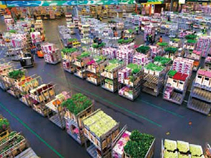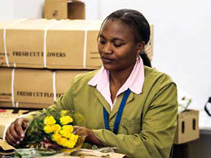Featured Past Articles
 Nini Flowers from Kenya was rewarded with the Dutch Flower Group Award last week. Owner Billy Coulson is very proud and feels honoured. ”We didn’t think we would win. We’ve got a strong relationship with DFG, but we didn’t realise we were already in that league. I’m very proud of our team.”
Nini Flowers from Kenya was rewarded with the Dutch Flower Group Award last week. Owner Billy Coulson is very proud and feels honoured. ”We didn’t think we would win. We’ve got a strong relationship with DFG, but we didn’t realise we were already in that league. I’m very proud of our team.”
What does the DFG Award mean to you?
”It’s a very prestigious award. We really appreciate our relationship with DFG. We’ve been their customer for six years now. Our connection goes back to 2011, when DFG and Mavuno entered into a strategic alliance. The award is the result of six years of collaborating. We were really surprised, but very proud. We didn’t think we would win. We’ve got a strong relationship with DFG, but we didn’t realise we were already in that league, if you know what I mean. I’m very proud of our team, too.”
Read more: DFG Award Winner: Billy Coulson: ‘We’re entirely focused on retail
 The False Codling Moth (Thaumatotibia leucotreta or FCM) is a threat to many of our flowers fruits, vegetables and other crops. Increased international trade and tourism has increased the risk of introduction of this pest. False Codling Moth can survive in climates described as tropical, dry or temperate. It is estimated that approximately 50 percent of the global environment may be suitable habitat for FCM.
The False Codling Moth (Thaumatotibia leucotreta or FCM) is a threat to many of our flowers fruits, vegetables and other crops. Increased international trade and tourism has increased the risk of introduction of this pest. False Codling Moth can survive in climates described as tropical, dry or temperate. It is estimated that approximately 50 percent of the global environment may be suitable habitat for FCM.
What is it
False codling moth is native to Ethiopia and sub-Saharan Africa. It is not known to be established in many parts of the world. Main routes of introduction are larvae on fruits, pods, or flowers. There are more than 70 potential hosts. The time for development is highly temperature defendant with up to five generations per year.
A female moth can lay up to 400 flattened-oval, pin-head sized eggs, usually placed singly. Young caterpillars are yellowishwhite with dark spots. Larvae can grow to be 1/2 inch in length and are bright red or pink with a yellow-brown head. On citrus, young larvae mine into the fruit, causing premature ripening.
You need to know how much water your irrigation system delivers in a given amount of time.
Automating irrigation based on plant needs is an option that can save a tremendous amount of water.
Water issues are a major concern around the world. Population growth and increased urbanization put increasing pressure on water supplies, making it increasingly important to use water more efficiently.
Addressing the challenges of using the right SFK during packaging and transit of flowers, would improve the quality and shelf life of flowers. SFK plays a crucial role in maintaining the quality flowers, but to get the maximum benefit, it must be the right quality and well used.
Silpack Industries Ltd, a national brand known all over the flower the flower growing areas for its innovative, durable, reliable and efficient packaging products and services has introduced yet another first in its SFK line. The super white SFK now undergoing trials with a number of growers may be the answer to numerous challenges faced by growers exporting to the direct market. The white Kraft made of 175gsm can withstand 10 hrs within the first 12 hrs, 9 hrs in 3 days and 7 hrs in 5 days. This is a characteristic which no other SFK can provide.
 Consumer behaviour is always changing. Sometimes buyers want a good quality plant or bunch of flowers for a low price. At other times they want something very special and purchase price is not an issue. Millennials are driving further growth in online sales. Babyboomers are set to retire and are expected to increase their expenditure on flowers and plants. In the next decade, Rabobank is expecting a 2% growth per year in cut flower and potted plant expenditures in Europe and North America, with Asia growing 6-8% annually. Rabobank expects the growing demand in Asia to be mainly fulfilled by products grown in Asia.
Consumer behaviour is always changing. Sometimes buyers want a good quality plant or bunch of flowers for a low price. At other times they want something very special and purchase price is not an issue. Millennials are driving further growth in online sales. Babyboomers are set to retire and are expected to increase their expenditure on flowers and plants. In the next decade, Rabobank is expecting a 2% growth per year in cut flower and potted plant expenditures in Europe and North America, with Asia growing 6-8% annually. Rabobank expects the growing demand in Asia to be mainly fulfilled by products grown in Asia.
Hybrid consumer
Nowadays, the cut flowers and plants consumer is unpredictable. One moment they want a very luxurious bouquet or exclusive plant, the next moment they buy a low-priced bunch of flowers at a discounter or big box retailer. They want different products at different times. We call this the ‘hybrid consumer’. This requires industry players to adapt their products and services to several consumer purchasing moments.
 The share of the rejected stems in the Kenyan supply chain from farm to the market with the current packaging is roughly 20% on average. A more standardized box will help us save on this. However growers could not well agree on what should be the first step in piloting a new box. While most agreed that the cost of the box would be the main consideration, others felt processes and handling procedures in the supply chain should dictate the standard box. Floriculture Magazine spoke to some of the industry stakeholders. Below are the excerpts:
The share of the rejected stems in the Kenyan supply chain from farm to the market with the current packaging is roughly 20% on average. A more standardized box will help us save on this. However growers could not well agree on what should be the first step in piloting a new box. While most agreed that the cost of the box would be the main consideration, others felt processes and handling procedures in the supply chain should dictate the standard box. Floriculture Magazine spoke to some of the industry stakeholders. Below are the excerpts:
Statistics available reveal that Kenya is losing millions in Cool Chain Management (Pack house, refrigerated Lorries’ road transport, cargo handling at the airport and cargo plane of flowers). Most of these losses are occasioned by the type of boxes used in the cool chain management and how they are handled. This makes our flowers less competitive in the market. Carton manufacturers must invest a lot to provide solution for these losses in addition to ensuring that there is no compromise on quality as well as training growers on cool chain and carton handling.
Read more: From Farm to Vase Building Sustainable Cut Flower Supply Chain
 Q : For export, Flowers must be packed. Kindly discuss the importance of quality cartons in packaging of flowers?
Q : For export, Flowers must be packed. Kindly discuss the importance of quality cartons in packaging of flowers?
A: The quality of a carton is important as it determines the state in which the produce will reach the market. A good quality box should be able to withstand the harsh conditions in the supply (cool) chain. The primary purpose of a carton is to protect, preserve and ship the produce to the market in top quality sustainably- in as near perfect condition as possible-allowing for good returns.
It is pointless to put so much effort in getting a quality produce from the farm only for it to arrive in bad state in the target market due to poor quality packaging fetching low returns and being subject of claims etc.
Q: For a layman, a carton is a carton; briefly discuss factors to consider when choosing the best carton for flowers?
A: A box is a box to a layman however you could have two boxes constructed of the same quality material (paper from same sources) but the resulting box could be very different in terms of capability- or ability to perform in the hostile conditions that it is subjected to.


